Multi-Wavelength Filters of Templated Blue Phase Liquid Crystal
Abstract
:1. Introduction
2. Materials and Fabrication Process of BPLC Templates
2.1. Materials Preparation
2.2. Fabrication Process of T-BPLC
3. Measurement and Analysis
4. Conclusions
Author Contributions
Funding
Conflicts of Interest
References
- Park, N.; Dawson, J.; Vahala, K. All fiber, low threshold, widely tunable single frequency erbium doped fiber ring laser with a tandem fiber Fabry-Perot filter. Appl. Phy. Lett. 1991, 59, 2369–2371. [Google Scholar] [CrossRef]
- Kersey, A.; Berkoff, T.; Morey, W. Multiplexed fiber Bragg grating strain-sensor system with a fiber Fabry-Perot wavelength filter. Opt. Lett. 1993, 18, 1370–1372. [Google Scholar] [CrossRef] [PubMed]
- Macleod, H. Turning value monitoring of narrow-band all-dielectric thin-film optical filters. Opt. Acta 1972, 19, 1–28. [Google Scholar] [CrossRef]
- Atia, A.; Williams, A. Narrow-bandpass waveguide filters. IEEE Trans. Microw. Theory Tech. 1972, 20, 258–265. [Google Scholar] [CrossRef]
- Mora, J.; Ortega, B.; Díez, A.; Cruz, J.; Andrés, M.; Capmany, J.; Pastor, D. Photonic microwave tunable single-band pass filter based on a Mach-Zehnder interferometer. J. Lightwave Techn. 2006, 24, 2500–2509. [Google Scholar] [CrossRef]
- Mitov, M. Cholesteric liquid crystals with a broad light reflection band. Adv. Mater. 2012, 24, 6260–6276. [Google Scholar] [CrossRef]
- Lavernhe, A.; Mitov, M.; Binet, C.; Bourgerette, C. How to broaden the light reflection band in cholesteric liquid crystals? A new approach based on polymorphism. Liq. Cryst. 2001, 28, 803–807. [Google Scholar] [CrossRef]
- Binet, C.; Mltov, M.; Boudet, A. Bragg reflections in cholesteric liquid crystals: From selectivity to broadening and reciprocally. Liq. Cryst. 1999, 399, 111–123. [Google Scholar] [CrossRef]
- Boudet, A.; Binet, C.; Mitov, M.; Bourgerette, C.; Boucher, E. Microstructure of variable pitch cholesteric films and its relationship with the optical properties. Eur. Phys. E 2000, 2, 247–253. [Google Scholar] [CrossRef]
- Mitov, M.; Binet, C.; Boudet, A.; Bourgerette, C. Glassy cholesteric broadband reflectors with a pitch gradient: Material design, optical properties and microstructure. Mol. Cryst. Liq. Cryst. 2001, 358, 209–223. [Google Scholar] [CrossRef]
- Huang, Y.; Zhang, S. Widely tunable optical filter with variable bandwidth based on the thermal effect on cholesteric liquid crystals. Appl. Opt. 2012, 51, 5780–5784. [Google Scholar] [CrossRef] [PubMed]
- Tondiglia, V.; Natarajan, L.; Bailey, C.; Duning, M.; Sutherland, R.; Yang, D.; Voevodin, A.; White, T.; Bunning, T. Electrically induced bandwidth broadening in polymer stabilized cholesteric liquid crystals. J. Appl. Phys. 2011, 110, 053109. [Google Scholar] [CrossRef]
- He, Z.; Ye, Z.; Cui, Q.; Zhu, J.; Gao, H.; Ling, Y.; Cui, H.; Lu, J.; Guo, X.; Su, Y. Reflection chromaticity of cholesteric liquid crystals with sandwiched periodical isotropic defect layers. Opt. Commun. 2011, 284, 4022–4027. [Google Scholar] [CrossRef]
- Young, N.; Ohtsuka, Y.; Jeong, S.; Nishimura, S.; Suzaki, G.; Takanishi, Y.; Ishikawa, K.; Takezoe, H. Fabrication of a simultaneous red-green-blue reflector using single-pitched cholesteric liquid crystals. Nat. Mater. 2013, 7, 43–47. [Google Scholar]
- Lin, J.; Chu, C.; Lin, H.; You, B.; Horng, C.; Huang, S.; Mo, T.; Huang, C.; Lee, C. Wide-Band tunable photonic band-gaps based on nematic refilling cholesteric liquid crystal polymer template samples. Opt. Mater. Express 2015, 5, 1419–1430. [Google Scholar] [CrossRef]
- Kikuchi, H.; Yokota, M.; Hisakado, Y.; Yang, H.; Kajiyama, T. Polymer-Stabilized liquid crystal blue phases. Nat. Mater. 2002, 1, 64. [Google Scholar] [CrossRef]
- Kikuchi, H.; Hisakado, Y.; Uchida, K.; Nagamura, T.; Kajiyama, T. Fast electro-optical effect in polymer-stabilized blue phases. In Proceedings of the SPIE 49th Annual Meeting Optical Science and Technology, Denver, CO, USA, 15 October 2004. [Google Scholar]
- Castles, F.; Day, F.; Morris, S.; Ko, D.; Gardiner, D.; Qasim, M.; Nosheen, S.; Hands, P.; Choi, S.; Friend, R.; et al. Blue phase templated fabrication of three dimensional nanostructures for photonic applications. Nat. Mater. 2012, 11, 599–603. [Google Scholar] [CrossRef]
- Hu, D.; Li, W.; Chen, X.; Ma, X.; Lee, Y.; Lu, J. Reconstruction research of blue phase liquid crystal. J. Soc. Inf. Display. 2016, 24, 593–599. [Google Scholar] [CrossRef]
- Hu, D.; Li, W.; Chen, X.; Ma, X.; Lee, Y.; Lu, J. Template effect on reconstruction of blue phase liquid crystal. J. Soc. Inf. Display. 2016, 24, 1582–1584. [Google Scholar] [CrossRef]
- Jie, X.; Lavrentovich, O. Blue-Phase-Polymer-Templated nematic with sub-millisecond broad-temperature range electro-optic switching. Appl. Phys. Lett. 2013, 103, 051112. [Google Scholar]
- Chen, Y.H.; Wang, C.T.; Yu, C.P.; Lin, T.H. Polarization independent Fabry-Pérot filter based on polymer-stabilized blue phase liquid crystals with fast response time. Opt. Express 2011, 19, 25441–25446. [Google Scholar] [CrossRef] [PubMed]
- Xu, D.; Peng, F.; Wu, S.T. Polymer-Stabilized Blue Phase Liquid Crystals. 2014. Available online: https://link.springer.com/content/pdf/10.1007/978-3-642-35947-7_191-1.pdf (accessed on 29 August 2019).
- Lin, T.H.; Chen, C.W.; Jau, H.C.; Lee, C.H.; Wang, C.T.; Wu, C.W.; Huang, H.P.; Khoo, I. Lasing Effect in Blue Phase Liquid Crystal. In Proceedings of the International Society for Optics and Photonics (Liquid Crystals XVII), San Diego, CA, USA, 25–29 August 2013. [Google Scholar]
- Chen, C.; Hou, C.; Li, C.; Jau, H.; Wang, C.; Hong, C.; Guo, D.; Wang, C.; Chiang, S.; Bunning, T.; et al. Large three-dimensional photonic crystals based on mono-crystalline liquid crystal blue phases. Nat. Commun. 2017, 8, 727. [Google Scholar] [CrossRef] [PubMed]
- Kim, K.; Hur, S.; Kim, S.; Jo, S.; Lee, B.; Song, M.; Choi, S. Well-Aligned simple cubic blue phase for a liquid crystal laser. J. Mater. Chem. C 2015, 3, 5383–5388. [Google Scholar] [CrossRef]

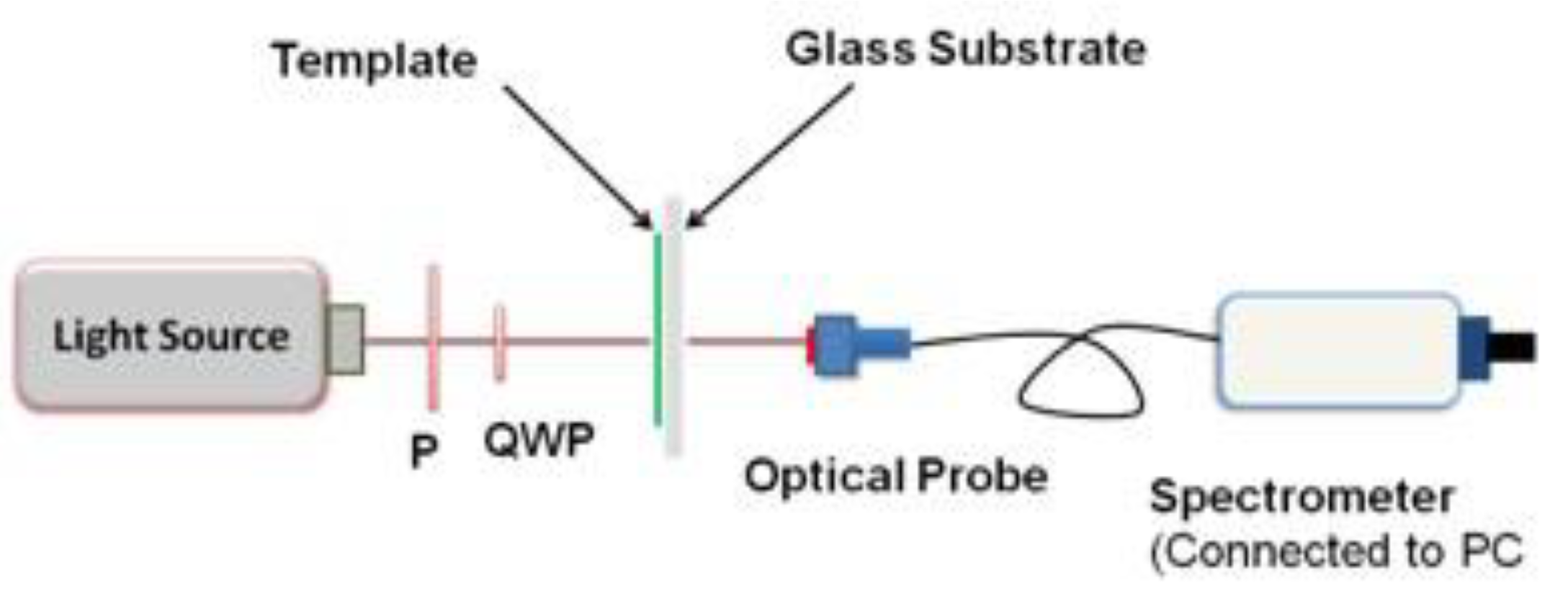
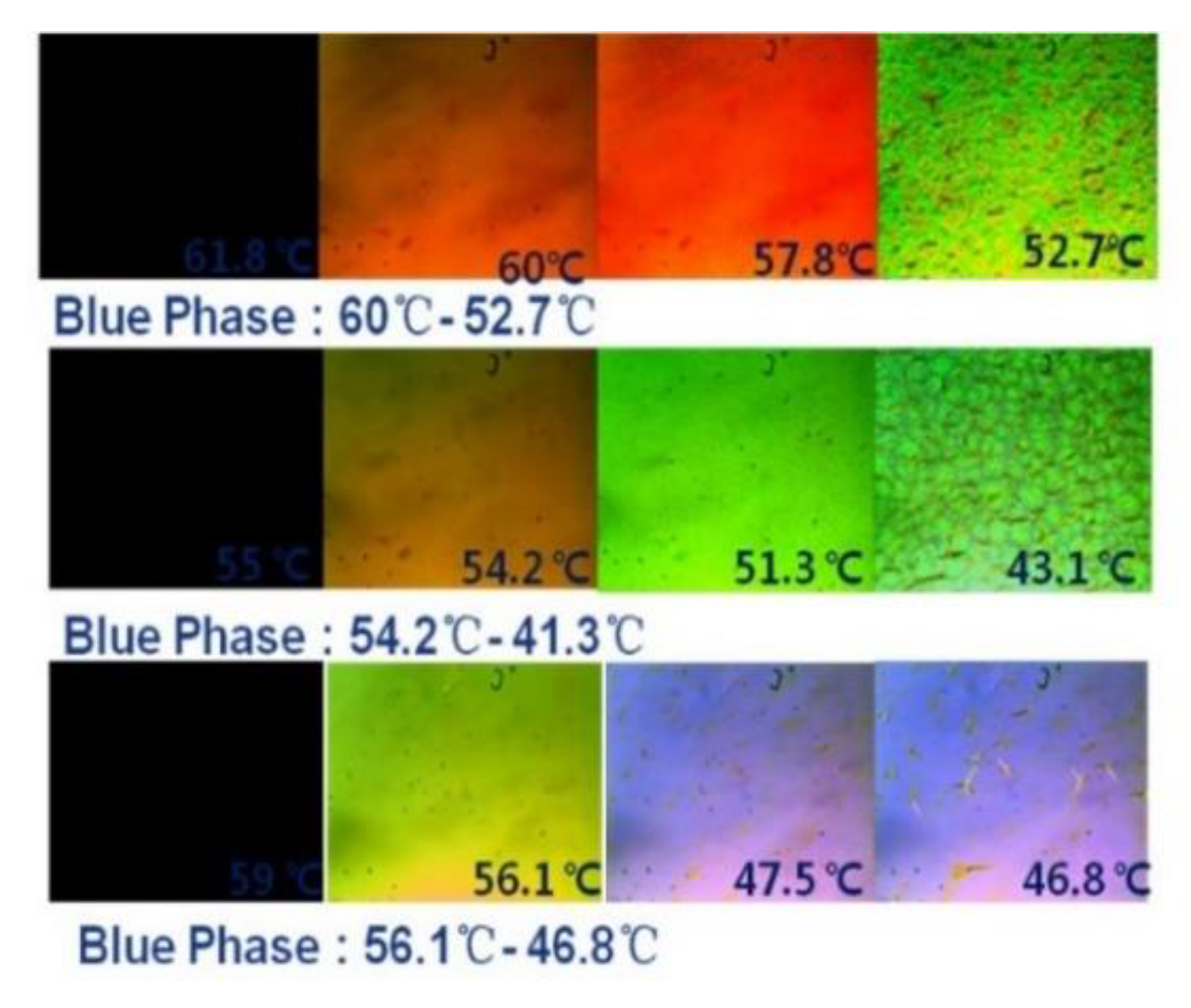
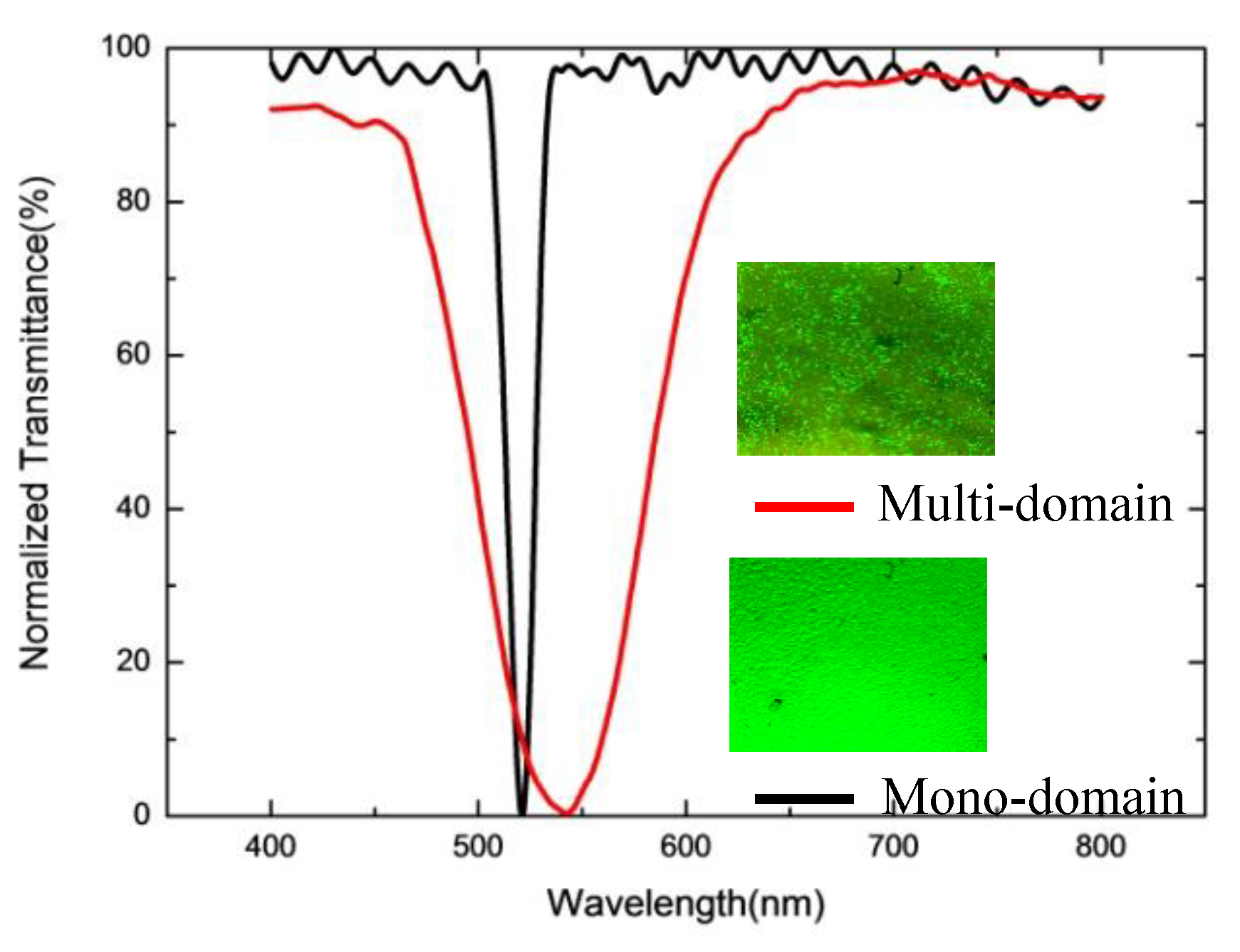
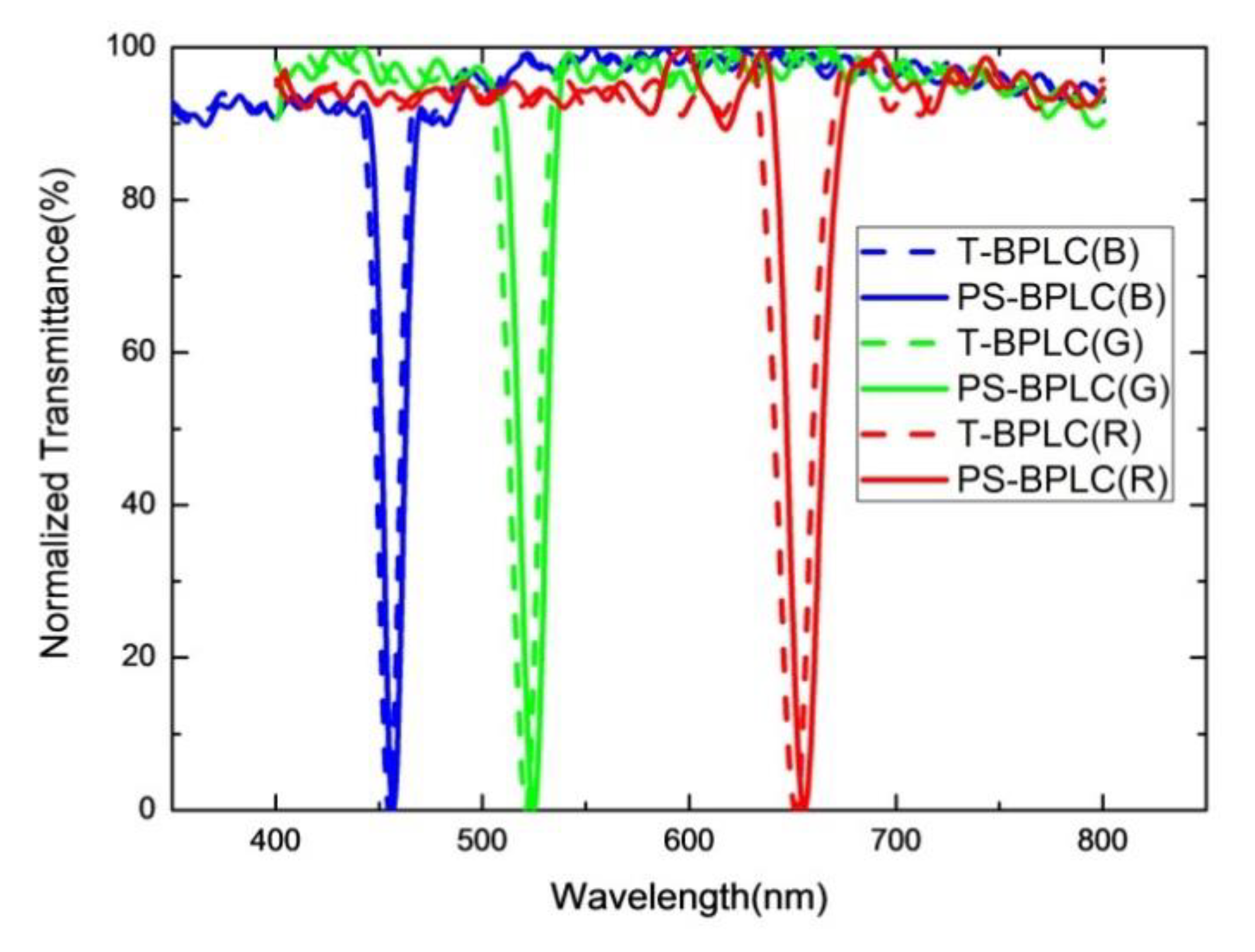
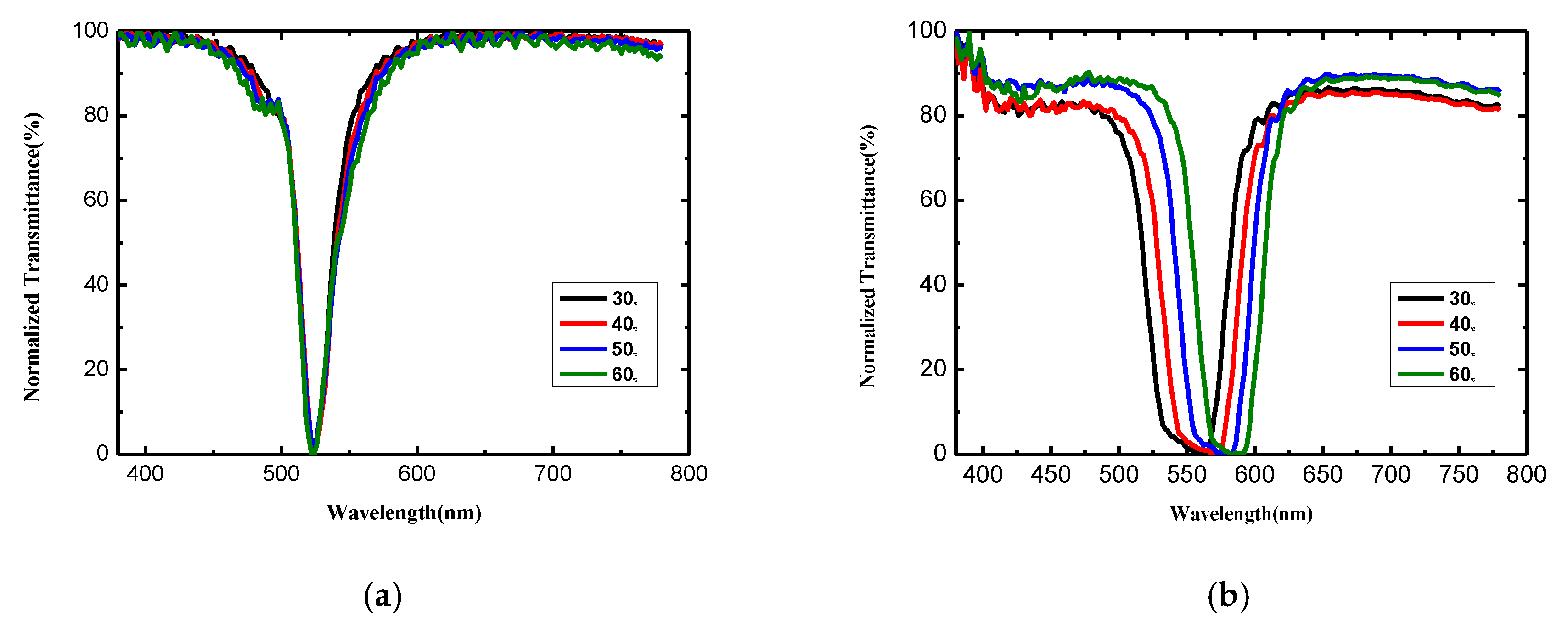
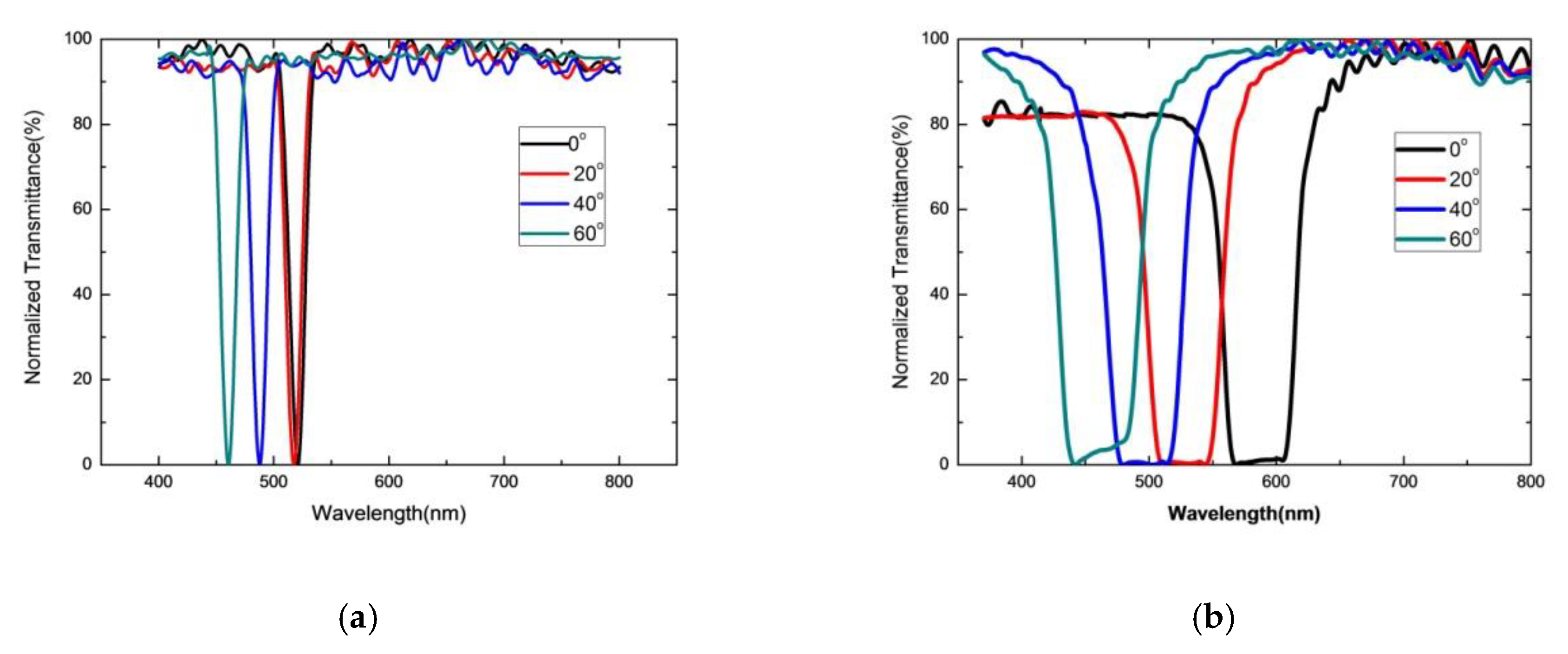
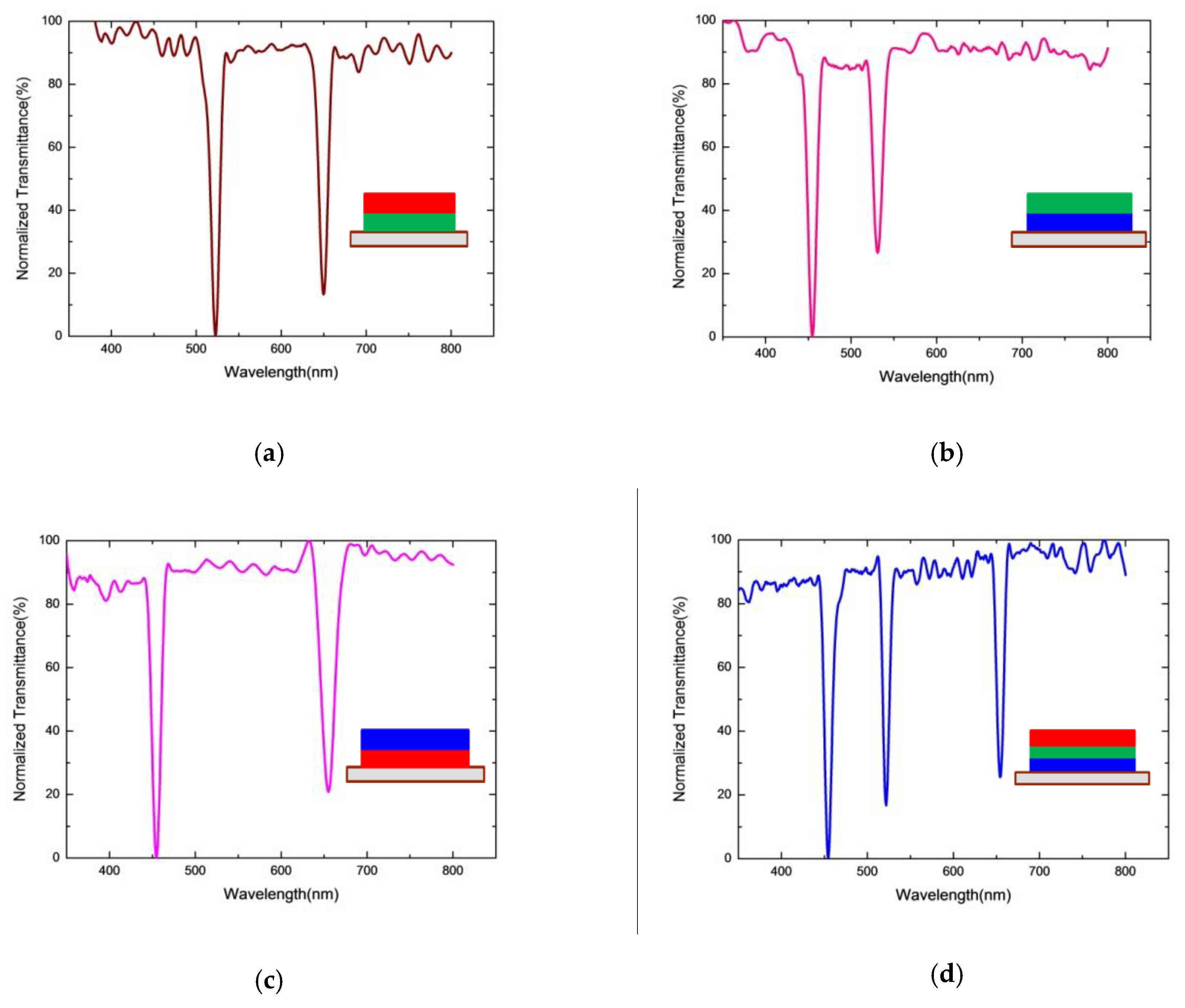
| HBG98 [wt%] | R5011 [wt%] | C3M [wt%] | TMPTA [wt%] | IRG184 [wt%] | |
|---|---|---|---|---|---|
| Red | 84.77 | 3.13 | 6.88 | 5.12 | 0.10 |
| Green | 84.48 | 3.42 | 6.85 | 5.15 | 0.10 |
| Blue | 84.30 | 3.60 | 6.90 | 5.10 | 0.10 |
© 2019 by the authors. Licensee MDPI, Basel, Switzerland. This article is an open access article distributed under the terms and conditions of the Creative Commons Attribution (CC BY) license (http://creativecommons.org/licenses/by/4.0/).
Share and Cite
Zha, S.; Zhang, H.; Sun, C.; Feng, Y.; Lu, J. Multi-Wavelength Filters of Templated Blue Phase Liquid Crystal. Crystals 2019, 9, 451. https://doi.org/10.3390/cryst9090451
Zha S, Zhang H, Sun C, Feng Y, Lu J. Multi-Wavelength Filters of Templated Blue Phase Liquid Crystal. Crystals. 2019; 9(9):451. https://doi.org/10.3390/cryst9090451
Chicago/Turabian StyleZha, Shenghao, Hongzhou Zhang, Changli Sun, Yifan Feng, and Jiangang Lu. 2019. "Multi-Wavelength Filters of Templated Blue Phase Liquid Crystal" Crystals 9, no. 9: 451. https://doi.org/10.3390/cryst9090451






